In academic terms, “object labeling” refers to the practice of providing detailed and structured information about an art object, artifact, or work of cultural or historical significance. Object labeling is a fundamental component of museums, galleries, and exhibitions, as it informs and educates visitors, researchers, and the public about the objects on display. These labels typically include relevant data about the object’s origin, historical context, artistic attributes, and other significant details, enhancing the audience’s understanding and appreciation of the artwork or artifact.
Key elements and concepts associated with object labeling in the academic context include:
Identification: Object labeling begins with the precise identification of the art object, including its title, artist or maker, date of creation, and other identifying information. This data helps visitors recognize and connect with the object.
Description: Labels provide a detailed and objective description of the art object’s physical attributes, including its size, materials, techniques, and stylistic features. This description assists in conveying the object’s visual characteristics.
Historical Context: Object labeling often includes information about the historical and cultural context in which the object was created. This context helps viewers understand the object’s significance and the era in which it was produced.
Interpretation: Labels may offer interpretative insights into the meaning, symbolism, and intended message of the artwork or artifact. This encourages viewers to engage with the object on a deeper level.
Provenance: Information about the object’s ownership history, acquisition, and exhibition history is important for establishing its provenance and providing insights into its journey through time.
Artist or Maker Biography: In the case of art objects, labels often provide brief biographies or contextual information about the artist or maker, helping viewers understand the creator’s background and artistic contributions.
Cross-References: Object labeling may include cross-references to related objects within the same exhibition or collection, encouraging visitors to explore thematic connections or artistic movements.
Multilingual Labels: In museums with international audiences, object labels may be presented in multiple languages to accommodate diverse visitors.
Accessibility: Ensuring labels are accessible to all visitors, including those with disabilities, is an important consideration. This may involve providing Braille labels, audio descriptions, or digital versions of the labels.
Citation: Object labels often include proper citations for reference and research purposes, allowing scholars and students to use the information in academic work.
Display: The placement and formatting of labels in the exhibition space are carefully considered to provide clear and unobstructed access to the information. This includes label placement next to or near the corresponding object.
Object labeling is a critical component of cultural institutions and museums’ public engagement and educational missions. It enables the dissemination of scholarly knowledge, promotes art appreciation, and enriches the visitor’s experience by providing a deeper understanding of the objects on display. Additionally, in academic research and curatorial work, the accurate and detailed labeling of objects is crucial for documentation, cataloging, and scholarly analysis.



